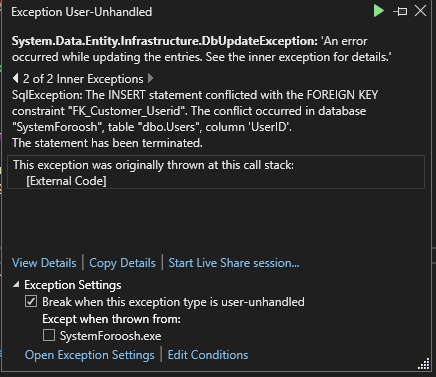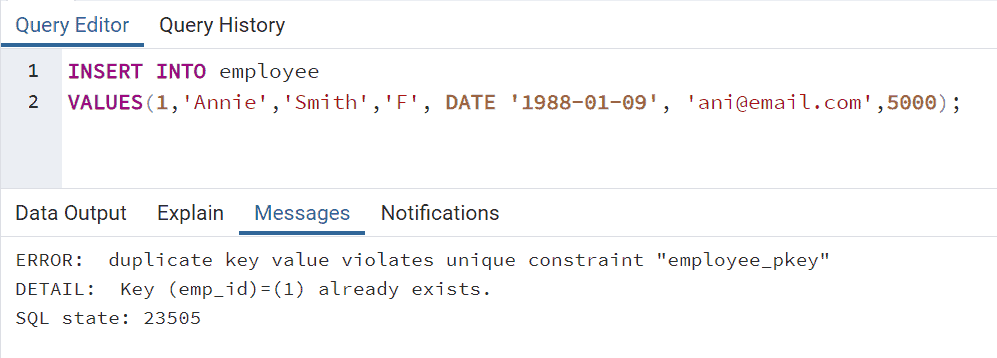The Insert Statement Conflicted With The Foreign Key Constraint
In database management systems, a foreign key is a field or a combination of fields that establishes a link or a relationship between two tables. It ensures the referential integrity of the data, meaning that it maintains the consistency and accuracy of the relationships between tables.
Foreign key constraints are rules that are applied to the data in the tables to enforce the relationship between them. These constraints ensure that any data inserted or updated in one table must meet the specified conditions or requirements of the relationship with another table.
Explanation of the Insert Statement
In database systems, an insert statement is used to add new data or records into a table. It allows users to insert values into specific columns or attributes of a table. However, when a foreign key constraint is enabled on a column or a set of columns in a table, it can cause conflicts with the insert statement.
Understanding the Relationship between Tables
To better understand the conflict with the insert statement and foreign key constraint, it is important to grasp the relationship between the tables involved. In a database, tables can have relationships such as one-to-one, one-to-many, or many-to-many.
For instance, let’s consider two tables, Table A and Table B. Table A may have a primary key column, which uniquely identifies each record, and Table B may have a foreign key column, which references the primary key column of Table A. This creates a relationship between the two tables.
Impact of Foreign Key Constraints on Insert Statements
Foreign key constraints impact insert statements in two ways: referential integrity and data validation. Referential integrity ensures that the data inserted into a foreign key column correlates to the primary key column of the referenced table. If the referenced value does not exist, the insert statement will fail.
Data validation ensures that the data being inserted complies with business rules or integrity constraints defined by the foreign key. For example, if a foreign key is defined as “not null,” any insert statement attempting to insert a null value will fail.
Common Reasons for Conflict with Foreign Key Constraints
There are several common reasons for conflicts with foreign key constraints:
1. Referencing non-existent or deleted records: If an insert statement is attempting to insert a value into a foreign key column that references a non-existent or deleted record in the referenced table, a conflict will occur.
2. Data type mismatch: If the data type of the foreign key column does not match the data type of the primary key column in the referenced table, a conflict will arise.
3. Secondary table restrictions: If a secondary table has its own foreign key constraints, the insert statement must meet the requirements of both tables’ foreign key constraints.
Troubleshooting the Conflict
When a conflict between an insert statement and a foreign key constraint occurs, it is crucial to troubleshoot the issue. To identify the root cause of the conflict, you can follow these steps:
1. Check for existing data: Ensure that the referenced record exists in the referenced table. If it doesn’t, you may need to check if the record has been deleted or if the insert statement is referencing incorrect data.
2. Validate data types: Verify that the data type of the foreign key column matches the data type of the primary key column in the referenced table. If not, you may need to modify the data types to resolve the conflict.
3. Examine secondary table restrictions: If there are multiple tables involved with foreign key constraints, review the requirements of each constraint to ensure that the data being inserted aligns with the constraints of both tables.
Resolving the Conflict through Data Modification
To resolve conflicts between insert statements and foreign key constraints, you may need to modify the data being inserted or the existing data. The following actions can help resolve the conflict:
1. Modify the insert statement: Verify that the insert statement is referencing the correct data and values. Update it accordingly to match the requirements of the foreign key constraint.
2. Update or delete existing data: If the referenced data does not exist or has been deleted, you may need to modify the existing data or restore the deleted data to satisfy the foreign key constraint.
Best Practices for Working with Foreign Key Constraints
To avoid conflicts with foreign key constraints, it is important to follow best practices:
1. Ensure data accuracy: Always verify the data being inserted or updated to make sure it aligns with the requirements of the foreign key constraint.
2. Use transactions: Utilize transactions when performing multiple insert or update operations to maintain the integrity of the data across multiple tables.
3. Maintain data consistency: Regularly check and update the data to ensure that the relationships between the tables are accurate and consistent.
4. Use indexes: Create indexes on the foreign key columns to improve the performance of the queries involving foreign key relationships.
FAQs
Q: What does “The insert statement conflicted with the foreign key constraint” mean?
A: This error message indicates that there is a conflict between an insert statement and a foreign key constraint. The data being inserted does not meet the requirements of the foreign key relationship, causing the constraint to be violated.
Q: How can I resolve conflicts between insert statements and foreign key constraints in C#?
A: To resolve conflicts in C#, you need to verify the data being inserted and ensure that it matches the requirements of the foreign key constraint. You may need to modify the insert statement or the existing data to satisfy the constraint.
Q: How can I handle conflicts between insert statements and foreign key constraints in Entity Framework?
A: In Entity Framework, conflicts can be handled by validating the data before inserting or updating, and catching any exceptions that occur. You can also use the DbSet.ValidateEntity method to validate the entity before saving it to the database.
Q: What should I do if the ALTER TABLE statement conflicts with the foreign key constraint?
A: If the ALTER TABLE statement conflicts with a foreign key constraint, you may need to modify the foreign key relationship or temporarily disable the constraint before making the desired changes.
Q: Why am I getting the “Could not drop object because it is referenced by a foreign key constraint” error?
A: This error occurs when you are attempting to drop an object (such as a table or a column) that is referenced by a foreign key constraint in another table. You need to first drop or modify the foreign key constraint before dropping the object.
Tsql: The Insert Statement Conflicted With The Foreign Key Constraint
What Does The Insert Statement Conflicted With The Foreign Key Constraint Mean?
When working with databases, you may encounter an error message that states, “The INSERT statement conflicted with the foreign key constraint.” This error message indicates that there is a problem when inserting data into a table, as it violates the foreign key constraint defined on that table. In this article, we will delve into the concept of foreign key constraints, explain why this error occurs, and provide solutions to resolve it.
Understanding Foreign Key Constraints
In a relational database, foreign keys are used to establish a relationship between two tables. A foreign key is a column or a set of columns in one table that refers to the primary key column(s) in another table. It is a way to define and enforce referential integrity, ensuring that data remains consistent between related tables.
Foreign key constraints specify rules for maintaining the relationship between tables. These constraints restrict the values that can be inserted or updated in the table containing the foreign key. They ensure that the data being added or modified adheres to the defined relationships, preventing invalid or inconsistent data from being entered into the database.
What Causes the “INSERT statement conflicted with the foreign key constraint” Error?
The “INSERT statement conflicted with the foreign key constraint” error occurs when a foreign key constraint is violated while inserting data into a table. This error can have several causes, which can be categorized into the following scenarios:
1. Inserting a non-existent value: If the value being inserted into the table does not exist in the referenced table’s primary key column(s), the foreign key constraint is violated. For example, if you are inserting a new record into the “Orders” table and the “CustomerID” column references the “Customers” table’s primary key, and you try to insert a value in “CustomerID” that does not exist in the “Customers” table, the error will occur.
2. Updating or deleting referenced data: If you attempt to update or delete data from a referenced table without considering the dependent tables, the foreign key constraint is violated. For instance, if you try to delete a record from the “Customers” table that has associated records in the “Orders” table, the deletion would conflict with the foreign key constraint.
3. Reordering statements: The order in which you execute your SQL statements can also cause this error. If you try to insert data into a table before inserting the referenced data, the foreign key constraint will be violated. It is vital to ensure that the order of your SQL statements maintains the appropriate sequence required by the foreign key constraints.
Resolving the “INSERT statement conflicted with the foreign key constraint” Error
To resolve this error, you can follow these suggested solutions:
1. Verify the values being inserted: Double-check the values you are attempting to insert into the table. Ensure that the values exist in the referenced table’s primary key column(s). If they do not, you may need to correct the values or add them to the referenced table beforehand.
2. Update or delete data carefully: When updating or deleting data, make sure to consider any dependent tables that may reference the data you intend to modify. Either update or delete the dependent data first or modify the foreign key constraints accordingly to allow the operation.
3. Reorder your statements: If the error occurs due to the order of your SQL statements, rearrange them to insert the referenced data before inserting the dependent data. By maintaining the appropriate sequence, you can avoid violating the foreign key constraint.
FAQs
Q: Can I disable foreign key constraints temporarily?
A: Yes, foreign key constraints can be temporarily disabled, typically during data import or maintenance, using the appropriate statement for the database management system you are using. However, it is important to exercise caution when disabling foreign key constraints, as it may lead to inconsistent data.
Q: Can there be multiple foreign key constraints on a table?
A: Yes, a table can have multiple foreign key constraints, each referencing different tables or even the same table.
Q: How can I identify the specific foreign key constraint that caused the error?
A: The error message usually provides the name of the constraint that was violated. By referencing the constraint name, you can identify the precise constraint causing the conflict.
Q: What happens if I ignore or disregard the foreign key constraint error?
A: Ignoring or disregarding the foreign key constraint error can lead to inconsistent data, as it allows the insertion of invalid or conflicting records. It is essential to address these errors to ensure data integrity and maintain referential consistency.
Q: Are foreign key constraints necessary in every database?
A: Foreign key constraints are not mandatory in every database, but they are highly recommended. They enforce data consistency and can help prevent data integrity issues and inconsistencies.
How To Resolve The Update Statement Conflicted With The Foreign Key Constraint?
When working with relational databases, foreign key constraints play a crucial role in ensuring data integrity. These constraints establish a relationship between tables, preventing actions that would violate the defined relationships. However, there are cases where an update statement conflicts with a foreign key constraint, causing an error message to appear. In this article, we will explore the reasons behind this conflict and provide solutions to resolve it.
Understanding Foreign Key Constraints:
Before delving into the conflict resolution, it is essential to understand the concept of foreign key constraints. A foreign key is a field (or a group of fields) in a table that refers to the primary key of another table. This relationship ensures the integrity between related tables and aids in maintaining consistent and accurate data.
When an update statement conflicts with a foreign key constraint, it typically happens when we attempt to update a column value that is referenced by other tables. This conflicts with the constraint, as it would create inconsistencies or break the relationship between the tables.
Resolving the Conflict:
Fortunately, there are several approaches to resolving a foreign key constraint conflict that arises during an update statement. Let’s explore some of the possible solutions:
1. Verify the Referential Integrity: The first step is to ensure that the integrity of the foreign key relationship is accurate. Double-check that the primary key values being referenced exist in the referenced table. If they do not match, it is necessary to correct the relationship or update the referenced values.
2. Temporarily Disable Constraints: Sometimes, it may be necessary to temporarily disable the foreign key constraints in order to update the conflicting table. However, it is essential to exercise caution while using this approach, as it can lead to inconsistent data if not properly managed. Disable the constraints, perform the necessary updates, and re-enable them once the changes are completed.
3. Update Cascades: Another strategy is to define cascading update actions when designing the foreign key constraints. By enabling the cascade update option, the update operation performed on the referenced table will automatically reflect the changes in the referencing table, eliminating the conflict. However, this approach should only be used when it aligns with the desired database design and business logic.
4. Merge or Delete Related Records: In some cases, resolving the conflict may require merging or deleting related records in the referencing table. This can be achieved by combining data from different related records into a single record or deleting unnecessary records. However, exercise caution and ensure that these actions do not adversely impact the data integrity or violate other constraints.
5. Use Triggers: Triggers can be utilized to automatically handle the necessary actions when an update statement conflicts with a foreign key constraint. By creating a trigger that executes a set of instructions upon encountering such conflicts, you can control and customize the resolution process to fit your specific needs.
Frequently Asked Questions (FAQs):
Q1. Why am I encountering an update statement conflict with a foreign key constraint?
This conflict usually arises when you attempt to update a column value that is referenced by other tables, causing inconsistencies or breaking the relationship.
Q2. How can I fix the update statement conflict?
To resolve the conflict, you can verify the referential integrity, temporarily disable constraints, use update cascades, merge or delete related records, or employ triggers.
Q3. Should I always disable constraints when encountering a conflict?
Disabling constraints should only be done when necessary, as it can lead to inconsistent data. It is crucial to re-enable the constraints once the updates are completed.
Q4. Can I use triggers to handle conflicts automatically?
Yes, triggers can be created to handle conflicts by defining the desired actions when a foreign key constraint conflict occurs.
Q5. Are there any drawbacks to using cascading updates?
Cascading updates can automatically resolve conflicts but could have unintended consequences on related data if used inappropriately. Use them judiciously and align them with the desired database design and business logic.
In conclusion, encountering conflicts between update statements and foreign key constraints is a common scenario in relational databases. By understanding the nature of these conflicts and employing appropriate strategies, such as verifying referential integrity, temporarily disabling constraints, using update cascades, merging or deleting related records, or utilizing triggers, one can effectively resolve these conflicts and maintain data integrity in the database.
Keywords searched by users: the insert statement conflicted with the foreign key constraint The insert statement conflicted with the foreign key constraint c#, The INSERT statement conflicted with the FOREIGN KEY constraint Entity Framework, The ALTER TABLE statement conflicted with the FOREIGN key constraint, The INSERT statement conflicted with the foreign key constraint OutSystems, The INSERT statement conflicted with the FOREIGN KEY SAME table constraint, Lỗi the ALTER TABLE statement conflicted with the foreign key constraint, The UPDATE statement conflicted with the foreign key constraint, Could not drop object because it is referenced by a foreign key constraint
Categories: Top 14 The Insert Statement Conflicted With The Foreign Key Constraint
See more here: nhanvietluanvan.com
The Insert Statement Conflicted With The Foreign Key Constraint C#
Understanding Foreign Key Constraints:
Before delving into the error, let’s first understand what a foreign key constraint is. In a database, a foreign key is a field or a set of fields that references the primary key of another table. It establishes a relationship between two tables, allowing data integrity and consistency. The foreign key constraint ensures that the values in the foreign key column(s) must exist in the primary key column(s) of the referenced table.
Causes of the Error:
The INSERT statement conflicted with the FOREIGN KEY constraint error occurs when you attempt to add a record to a table that references another table, but the value you are trying to insert does not exist in the referenced table. This can happen due to several reasons:
1. Incorrect Data: The value you are trying to insert does not match any existing primary key value in the referenced table. For example, if you are trying to insert a customer record with a foreign key that references the Orders table, but there is no corresponding Order ID in the Orders table.
2. Missing Data: The referenced table might be missing the necessary data. If the table you are trying to reference is empty or does not contain the desired value, the INSERT statement will fail.
3. Disabled Constraints: Sometimes, developers disable foreign key constraints for various reasons, such as data migration or bulk insert operations. Forgetting to enable the constraints after such operations can result in this error.
Solutions to the Error:
Now that we understand the causes, let’s explore some solutions to resolve the “INSERT statement conflicted with the FOREIGN KEY constraint” error:
1. Verify Data: Double-check the data you are trying to insert. Ensure that the foreign key value exists in the referenced table. If not, you may need to insert the corresponding record in the referenced table first.
2. Update Existing Data: If the referenced table is missing the required data, you can try updating the existing records to contain the necessary values. This can be done through an UPDATE statement, taking care to match the foreign key values correctly.
3. Enable Constraint Validation: If you have intentionally disabled the foreign key constraints, make sure to enable them after performing the necessary operations that made it necessary to disable them. Failure to enable these constraints can lead to this error.
4. Use Transactions: Wrap your insert statements within a transaction to ensure data consistency. Begin a transaction, perform the insert operation, and commit the transaction only if all the dependent tables have the required data. If any error occurs, rollback the transaction to its initial state.
Frequently Asked Questions (FAQs):
Q1: Why am I getting the “INSERT statement conflicted with the FOREIGN KEY constraint” error?
This error occurs when you attempt to insert a record that references another table through a foreign key constraint, but the value you are trying to insert does not exist in the referenced table.
Q2: How can I resolve this error?
To resolve this error, you need to ensure that the referenced value exists in the table you are referencing. Verify the data you are trying to insert, update existing data if necessary, enable constraint validation if disabled, or use transactions for data consistency.
Q3: Can I disable foreign key constraints permanently to avoid this error?
It is not advisable to disable foreign key constraints permanently. These constraints are crucial for maintaining data integrity and consistency. Disabling them can lead to data corruption and other issues. Only disable constraints temporarily when necessary, remembering to enable them afterward.
Q4: Is it possible to insert a record with a foreign key that references a NULL value?
Yes, it is possible to have a foreign key that references a NULL value. However, it is essential to handle NULL values appropriately and ensure they are treated as intended in your database design.
In conclusion, the “INSERT statement conflicted with the FOREIGN KEY constraint” error is a common issue that arises when working with databases in C#. By understanding foreign key constraints, their causes, and implementing the suggested solutions, developers can overcome this error and ensure data integrity in their applications.
The Insert Statement Conflicted With The Foreign Key Constraint Entity Framework
Foreign key constraints are used in database design to establish a relationship between two tables. They ensure that the data being inserted or updated adheres to referential integrity, meaning that any value in the foreign key column must exist in the referenced table’s primary key column. The goal is to maintain data consistency and avoid orphaned records.
Causes of the “The INSERT statement conflicted with the FOREIGN KEY constraint” error:
1. Unmatched foreign key value:
This error is commonly reported when attempting to insert a value into a foreign key column that does not exist in the referenced table’s primary key column. For example, if there is a foreign key constraint between the “Orders” and “Customers” tables, inserting an order with a nonexistent customer id would trigger this error.
2. Data manipulation order:
When inserting or updating records, it is crucial to ensure that the data manipulation commands are executed in the correct order to satisfy the foreign key constraints. For instance, attempting to insert a child record before the parent record can result in this error.
3. Disabled or improperly defined constraints:
In some cases, the foreign key constraint might be disabled or improperly defined, causing this error to occur. It is essential to double-check the constraint definition to ensure it aligns with the intended logic.
Potential solutions for the “The INSERT statement conflicted with the FOREIGN KEY constraint” error:
1. Verify data integrity:
Check the data being inserted or updated to ensure that the foreign key value exists in the referenced table’s primary key column. Validate the input against the available options to avoid any mismatches.
2. Adjust data manipulation order:
Ensure that the foreign key constraints are satisfied by executing the data manipulation commands in the appropriate order. Insert parent records before inserting child records to prevent conflicts.
3. Enable or redefine constraints:
If the foreign key constraint is disabled or incorrectly defined, re-enable or redefine it following the proper logic. Consult database documentation or seek assistance from a database administrator if needed.
4. Review referential actions:
Foreign key constraints can be set to perform actions when a referenced record is deleted or updated. Review the referential actions associated with the foreign key constraint to ensure they are set correctly. This can help prevent conflicts when modifying related records.
Frequently Asked Questions (FAQs):
Q1. Can I temporarily disable foreign key constraints?
A1. Yes, it is possible to temporarily disable foreign key constraints. However, this should be done with caution, as it can lead to inconsistent data if not managed properly. Use the ALTER TABLE statement to disable/re-enable constraints.
Q2. How can I identify the specific constraint causing the error?
A2. The error message usually indicates the name of the conflicting constraint. In most cases, it will specify which table and column are involved, making it easier to identify and resolve the issue.
Q3. Can I insert data into the table with a NULL foreign key?
A3. It depends on the constraint definition. If the foreign key constraint allows NULL values, you can insert data with a NULL foreign key. Otherwise, you must provide a valid foreign key value that exists in the referenced table.
Q4. Why am I still encountering the error even after verifying the data integrity?
A4. Double-check the integrity of the indexed columns used in the foreign key constraint. Ensure that the indexed columns are the same data type and length as the primary key they reference. Even small differences can cause conflicts.
Q5. I don’t have control over the constraint definitions. How can I handle this error?
A5. If you are working on a project where the database schema is managed by another team, collaborate with them to resolve the issue. Communicate the encountered error and provide the necessary details for them to investigate and adjust the constraint definitions accordingly.
In conclusion, encountering “The INSERT statement conflicted with the FOREIGN KEY constraint” error is a common occurrence when working with Entity Framework and databases. Understanding the causes and implementing the suggested solutions can help overcome this issue efficiently. However, always ensure to maintain the integrity of the data and follow appropriate conventions to avoid such conflicts.
The Alter Table Statement Conflicted With The Foreign Key Constraint
When working with relational databases, such as MySQL, PostgreSQL, or SQL Server, tables can be linked together using foreign key constraints. These constraints ensure data integrity and enforce referential integrity between related tables. Foreign keys are used to establish relationships between tables by linking a field (or combination of fields) in one table to the primary key of another table.
The ALTER TABLE statement is commonly used to modify the structure of existing database tables, such as adding or removing columns, changing data types, or modifying constraints. However, while performing such modifications, you may encounter the “ALTER TABLE statement conflicted with the FOREIGN key constraint” error message. This occurs when the modification violates an existing foreign key constraint and prevents the action from being executed.
There are several reasons why this error might occur. The most common cause is when you attempt to delete or modify a record that is referenced by a foreign key constraint in another table. For example, if you try to delete a record from a parent table that has child records in a related table, the foreign key constraint will prevent the deletion operation.
Another scenario leading to this error is when you try to modify a foreign key itself. Modifying a foreign key involves changing the referenced table or column, altering the constraints, or specifying ON UPDATE or ON DELETE actions. If these modifications conflict with the existing foreign key constraints, the error will be flagged.
To resolve this error, you need to carefully analyze the cause and potentially adjust your database design or modify your SQL statements accordingly. Here are a few possible solutions:
1. Make sure all data dependencies are considered: Before modifying a table, it is essential to identify all dependencies and relationships involving the table. Check if any foreign keys reference the table being modified and the actions associated with them. If necessary, modify or delete those references before executing the ALTER TABLE statement.
2. Use appropriate ON DELETE and ON UPDATE actions: When modifying a foreign key, it is common to specify actions that are triggered when referenced rows are deleted or updated. Ensure that these actions are suitable for your requirements and aligned with the structure and data in the related tables. For instance, specify ON DELETE CASCADE to delete all related child rows automatically when a parent row is deleted.
3. Temporarily disable foreign key constraints: In some cases, you may need to temporarily disable foreign key constraints to complete the desired modifications successfully. However, exercise caution when using this approach as it may compromise data integrity. After completing the modification, remember to enable the foreign key constraints again.
4. Review cascading actions: If a foreign key constraint initiates cascading actions like delete or update, double-check that all associated tables and relationships are properly handled to avoid conflicts. Analyze the potential effects of cascading actions on related tables and determine whether adjustments are necessary.
Now, let’s address some frequently asked questions related to this topic:
Q1: Can I modify a table with foreign key constraints without encountering this error?
Yes, it is possible to modify a table with foreign key constraints. However, you need to carefully consider the dependencies and relationships between the tables and ensure that your modifications do not violate any foreign key constraints.
Q2: What are the potential risks of disabling foreign key constraints temporarily?
Disabling foreign key constraints temporarily can introduce data integrity issues. If you perform modifications that violate referential integrity while the constraints are disabled, it can lead to orphaned records or data inconsistencies. Therefore, it is essential to re-enable the constraints after making the necessary modifications.
Q3: Is it better to use soft deletes instead of deleting records when faced with this error?
Soft deletes involve marking a record as deleted instead of physically removing it from the database. This approach can be useful in scenarios where you want to maintain the historical data without breaking foreign key constraints. However, it depends on your specific requirements and the nature of your application.
In conclusion, encountering the “ALTER TABLE statement conflicted with the FOREIGN key constraint” error can be frustrating but understanding the causes and solutions can help you effectively address it. By carefully analyzing the dependencies, using appropriate actions, and considering the potential impacts of modifications, you can successfully modify tables without violating foreign key constraints. Remember to review your database design and consult the documentation of your chosen database management system for specific instructions on handling foreign key constraints.
Images related to the topic the insert statement conflicted with the foreign key constraint

Found 47 images related to the insert statement conflicted with the foreign key constraint theme

















































Article link: the insert statement conflicted with the foreign key constraint.
Learn more about the topic the insert statement conflicted with the foreign key constraint.
- INSERT statement conflicted with the FOREIGN KEY constraint
- The INSERT statement conflicted with the … – Microsoft Learn
- The Insert Statement Conflicted With the Foreign Key Constraint
- Hỏi về lỗi INSERT xung đột với Khóa ngoại – DayNhauHoc.com
- INSERT statement conflicted with the FOREIGN KEY constraint
- The UPDATE statement conflicted with the REFERENCE constraint
- SQL Server Error Messages – Msg 547
- How to Add Foreign Key in SQL – Javatpoint
- lỗi insert trong sql – How Kteam
- The insert statement conflicted with foreign key constraint
- INSERT statement conflicted with the FOREIGN KEY constraint
- The INSERT statement conflicted with the … – OutSystems
- SQL Server Error Messages – Msg 547